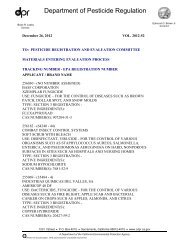Dichlorvos (DDVP) Risk Characterization Document - California ...
Dichlorvos (DDVP) Risk Characterization Document - California ...
Dichlorvos (DDVP) Risk Characterization Document - California ...
Create successful ePaper yourself
Turn your PDF publications into a flip-book with our unique Google optimized e-Paper software.
TABLE 1: Reported Uses of <strong>DDVP</strong> During 1990 (DPR, 1992).<br />
================================================================================<br />
USE LB APPLIED PERCENT OF TOTAL LB. APPLIED<br />
Struc. Pest Cont. 2,252 46%<br />
Cattle, Beef and Dairy 826 17%<br />
Poultry 715 15%<br />
Rights-of-way 276 6%<br />
Landscape and Ornamentals 256 5%<br />
Vertebrate Pest Control 174 3%<br />
Other Uses 398 8%<br />
TOTAL 4,897 100%<br />
================================================================================<br />
Formoli, WH&S, 1992<br />
The reported sale of <strong>DDVP</strong> in <strong>California</strong>, as shown in Figure I, has been in a sharp decline for last several years<br />
(DPR, 1984-1990). The reported sale for 1984 was 117,213 lbs <strong>DDVP</strong> and it was reduced to only 17,301 lbs for<br />
1990. The discrepancy between pounds used and pounds sold in 1990 are in the home-use formulations which did<br />
not require use reporting.<br />
Use of <strong>DDVP</strong> in agriculture has been in decline for a number of years. Livestock use has shown the material to not<br />
be adequately effective in controlling horn and face flies and has resulted in reduction of use. Poultry producers, as<br />
reported by the UC Agricultural Extension, have great concerns over egg and meat residues and potential<br />
intoxication of the poultry from the "tight- ventilation" conditions of the poultry house. Outside the production<br />
facility some formulations are still apparently used.<br />
Structural pest control use has dwindled to a very small user base. Because of <strong>DDVP</strong>'s volatility, it has good<br />
"penetrating power" and is used for crack-crevice or spot-type treatments.<br />
DERMAL ABSORPTION<br />
A dermal absorption study of <strong>DDVP</strong> technical in male rats was submitted by the registrant (Jeffcoat, 1990). Rats<br />
were divided into three dose groups. The fur on the back of each rat was clipped. 14 C-labeled <strong>DDVP</strong> was mixed<br />
with unlabeled <strong>DDVP</strong> and applied to the clipped back of rats at three dose levels (30, 3, and 0.3 ug/cm 2 ). The<br />
dosing solution was prepared with water. Each dose group was subdivided into three sacrifice times of 10, 24, and<br />
120 hours. Exhaled 14 CO 2 , urine, and feces were collected at 10 hours, 24 hours and each subsequent 24-hour<br />
period until sacrifice.<br />
The overall total radioactivity recovery of the administered dose ranged from 96.0 to 99.3 percent. Percent dermal<br />
absorption at each observation period and dose level is shown in Table 2. Dermal absorption of <strong>DDVP</strong> ranged from<br />
10 to 13 percent of the applied dose in rats observed for 120 hours. A dermal absorption of 13 percent will be used<br />
in this document to estimate absorbed daily dosage.<br />
2
















